Baseball never saw anything quite like the Yeli & Belli Show of 2019. Christian Yelich of the Brewers, then 27, and Cody Bellinger of the Dodgers, 23, played a game of statistical H-O-R-S-E within a season that made for exciting baseball and amusing national TV ads. They finished first and second, respectively, in slugging and OPS, but it was Bellinger who won the MVP over Yelich, the ’18 MVP.
In amazing displays of five-tool prowess, Yelich and Bellinger slashed better than .300/.400/.600 with at least 44 homers and 15 stolen bases. It marked the first season in which two players so young reached those levels. Only four players under 27 preceded them: Babe Ruth (1921), Willie Mays (’55), Ken Griffey Jr. (’93) and Chipper Jones (’99).
Walking in the footsteps of first-ballot Hall of Fame giants, Yeli and Belli seemed destined for greatness. The traditional prime years of a ballplayer still lay ahead.
Just two seasons later, Yelich and Bellinger are two of the biggest enigmas in baseball. Rarely have players crashed so far and so fast. Since the start of the 2020 season, 210 players have taken 500 plate appearances. Yelich (.234) ranks 177th in batting and Bellinger (.195) ranks 205th.
What happened to Yelich and Bellinger? Can the back-to-back, Yeli-to-Belli MVPs get back to where they were in 2019?
To answer those questions, I took deep dives into their descent from four perspectives: historical, physical, analytical and mechanical. Here is what happened to the Yeli & Belli Show—and if we will ever see it again.
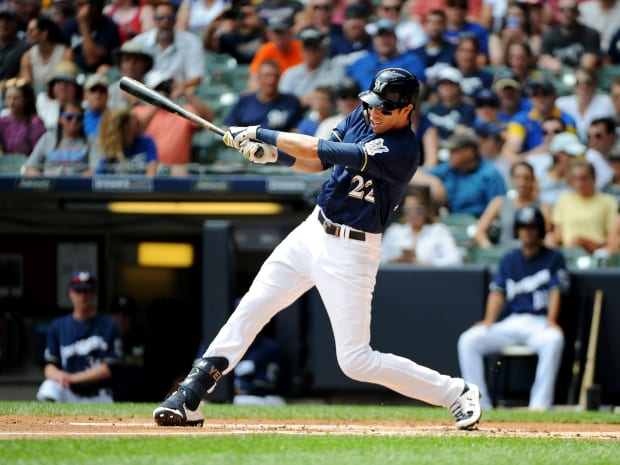
Michael McLoone/USA TODAY Sports
Christian Yelich
What History Tells Us...
A good hitter with Miami (.290/.369/.432), Yelich broke out with two huge seasons after his trade to Milwaukee (.327/.415/.651), where he especially thrived at home. Yelich slugged .699 at home and .569 on the road over those seasons.
In those two seasons, Yelich became the first player to reach 80 homers and 50 stolen bases in age 26–27 seasons. Dropping the thresholds to 70 homers and 40 steals to find like players at that age with such power and speed, you get Dale Murphy, Sammy Sosa, Chipper Jones, Vladimir Guerrero and Alfonso Soriano. All remained productive through their 30s except Murphy, who hit .234 and declined rapidly after his last good year at 31.
What His Health Tells Us...
Yelich broke his right kneecap in September 2019. In ’21, he missed three weeks with a sore back, came back to play one game, then missed another two weeks with the same back ailment. His back has troubled him since his days in the minor leagues.
Brewers president David Stearns said at the end of last season, “Clearly he wasn’t right this year, and he wasn’t right last year, either. There may be different reasons in each of those two years why we couldn’t quite get it going, but it should be a priority for the organization.”
What the Metrics Tell Us...
Yelich lost the ability to consistently hit the ball in the air.
*7th in MLB
Stearns is correct that there are different primary reasons for the decline in the past two seasons. In 2020, Yelich hit the ball harder than he did in ’19, but he was too passive. His swing rate declined from 45.2% to 34.6%, most curiously when the count was in his favor, from 50.2% to 40.2%. Maybe it was partly due to the strange season with empty stands caused by COVID-19.
The 2021 season shows more cause for alarm. Yelich stopped squaring up the ball:
Highest Increase in Pct. Of Topped Balls, 2020–21
Yelich also lost 3 mph in exit velocity, tied for the fourth-worst decline.
What the Video Tells Us...
Loss of exit velocity, like loss of fastball velocity for a pitcher, often is a red flag for injury (Matt Chapman, minus-3.9 mph last year, tied for worst in MLB) or decline (Brett Gardner, minus-3.2; Gregory Polanco, minus-3). Yelich lost his explosiveness because of his back injury.
Take a look at Yelich at the pitcher’s release point from 2019 and ’21—against Tyler Beede on the left and Zack Wheeler on the right. Both pitches will be fastballs down the middle.
The major difference is in Yelich’s spine angle. In 2019, he is in a much more coiled position. I’ve drawn an orange line from the “M” logo of his batting helmet straight down. The bend in his spine angle keeps his head over his knee and the ball of his foot, just as it should be—the perfect “ready” balanced, athletic position of someone playing defense in basketball, waiting for the return of service in tennis, addressing a golf ball or lining up for man coverage against a receiver.
Look at that same orange line in 2021. The spine angle is more upright. The head is behind the knee. The center of gravity is farther back. He is standing in the same spot in the batter’s box, but his head is farther from the hitting zone. He is not as balanced. He's leaning back even before he starts his swing. As with a golf swing, if you begin off balance you fight to get balanced throughout the swing.
Yelich 2019 vs. Yelich 2021
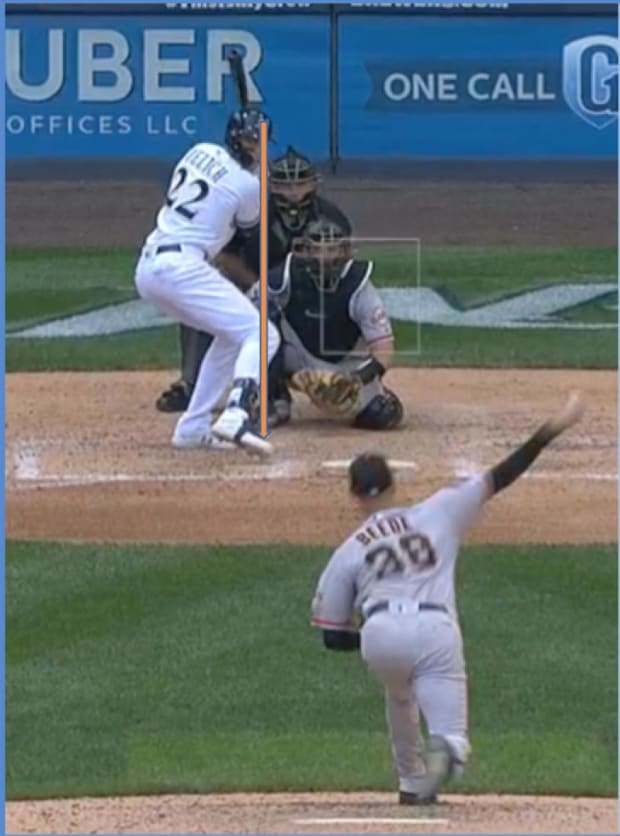
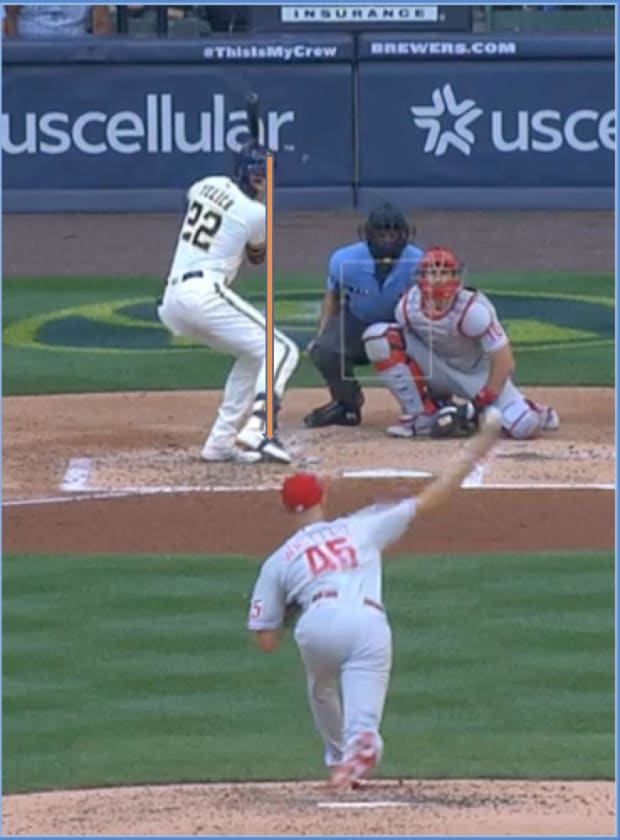
When we move the video forward to the moment when the ball is in the hitting zone, you see the effect of what it means to start on balance or not. In 2019 he is perfectly on time. The head is down, and the arms are connected to the body (note the lack of gap between his back elbow and torso). Everything is in sync.
In 2021, you can see how his head remains farther away from the baseball and the connection is lost. The arms must work away from the body to get to the baseball, which slows the swing. (While watching the Olympics, take note of when skaters want to spin fast and when they want to come out of the spin. To spin faster you pull the arms in. To slow or end the spin you extend the arms away from the torso.) Yelich is pulling off the baseball because he started with a more upright spine angle and never did get to the proper connection and balance.
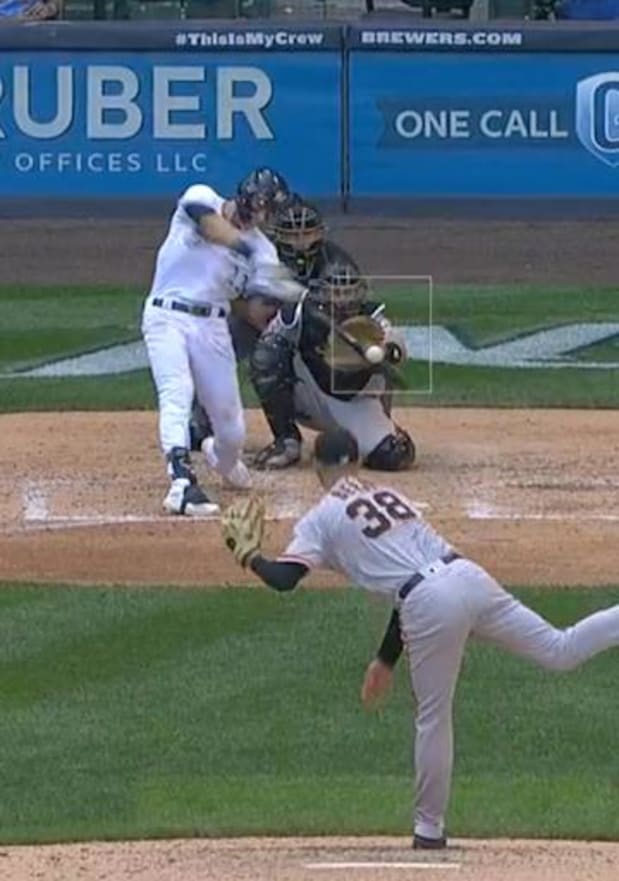
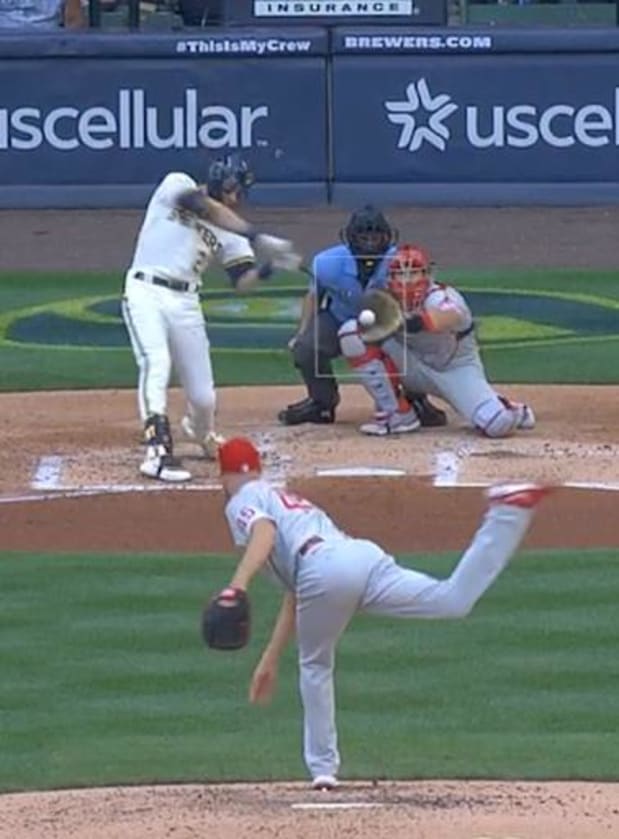
What do you think were the outcomes of these two swings? The metrics say it all:
1. July 14, 2019 vs. Tyler Beede
Result: Home run to CF
Distance: 418 feet
Launch Angle: 21 degrees
Exit Velocity: 106.3 mph
2. Sept. 6, 2021 vs. Zack Wheeler
Result: Ground out to 1B
Distance: 2 feet
Launch Angle: minus-52 degrees
Exit Velocity: 82.8 mph
The 2019 Yelich crushed a middle/middle fastball to centerfield for a home run. The ’21 Yelich pulled off the same pitch, causing him to top the ball weakly to the pull side.
Sign up to get the Five-Tool Newsletter in your inbox every week during the MLB offseason.
What the Future Holds...
The answer lies predominantly with the condition of Yelich’s back. Is this a chronic problem? Does he need more days off as a preventative measure? Is he healthy enough to return to that coiled position with a better spine angle?
A cautionary answer to these questions is found in the career of Don Mattingly, a guy who also hit from a coiled position but became more of an upright hitter with less power after he hurt his back in May 1987. Mattingly described his back problem as a congenital defect. The injury in ’87 made a bad back worse.
Here is how Mattingly (through 1987 at 26) and Yelich (through 2019 at 27) compare before their declines:
Mattingly played 60% of his career games after that historic stretch. He slashed .292/.347/.424 post-injury. His OPS+ dropped from 150 to 112, which means he went from a Hall of Fame level to a very good hitter, analogous to Kyle Seager (career OPS+: 112).
Yelich could return to his 2019 level, or he could transition to the Mattingly 2.0 version, or—worst case scenario—he hits a steep decline like Murphy. The condition of his back will have the biggest effect on that course.
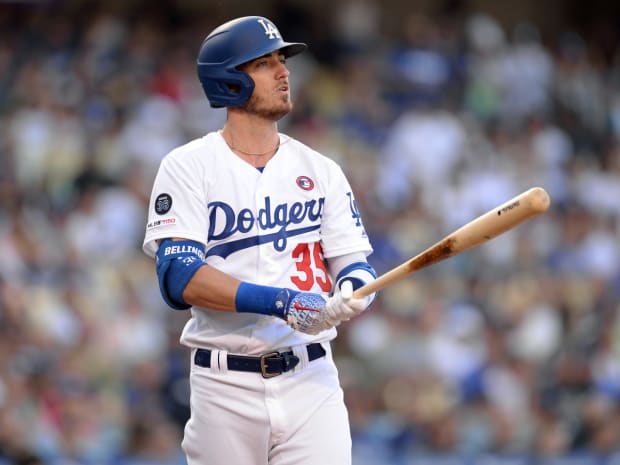
Gary A. Vasquez/USA TODAY Sports
Cody Bellinger
What History Tells Us...
If you held a showcase-style tryout among all MLB players in 2019, Bellinger might have won it with his combination of speed, power, athleticism and defensive versatility. That year he joined Griffey as the only players as young as 23 to combine at least 40 homers and 15 stolen bases while posting an OPS greater than 1.000.
Since then, Bellinger has hit .195 and slugged .364 over two seasons. It is almost impossible to find another young player who was this good and turned this bad so quickly. The closest comps might be Fred Lynn and Jeff Burroughs, who like Bellinger each won an MVP award at 23.
Two years after his MVP, Lynn slumped to .260 in 1977, but largely because he was recovering from torn ankle ligaments. He bounced back with a solid season in ’78 and his best year in ’79.
After Burroughs won the 1974 AL MVP, he slumped badly for two seasons (.409 and .369 slugging) while trying to hit more pull-side home runs. Traded from Texas to Atlanta, he bounced back with a career-high 41 homers in ’77.
What His Health Tells Us...
Bellinger famously dislocated his right shoulder with a celebratory forearm bump with teammate Kiké Hernández in the 2020 NLCS Game 7. Having suffered previous dislocations, Bellinger underwent surgery to tighten the labrum. In ’21, he landed on the IL with three injuries: a hairline fracture in his left leg (missed 47 games), left hamstring tightness (10 games) and left rib cage fracture (nine games).
What the Metrics Tell Us...
Bellinger lost his ability to hit velocity, especially up in the strike zone.
Bellinger vs. Fastballs by Height (By Feet Off Ground)
A .327 hitter against fastballs in 2019, Bellinger was the worst hitter in baseball last season on fastballs (.150, minimum 500 fastballs). He was especially terrible on high fastballs (.115, at least 2.5 feet off the ground). Pitchers kept exploiting an obvious hole in his swing. He saw the 10th highest percentage of high fastballs.
Bellinger chased more often, increased his angle of attack, got under the ball more often and missed more often:
What the Video Tells Us...
During the 2020 COVID-19 shutdown, Bellinger tinkered with his setup. It probably set him back. The shoulder surgery limited his spring training workload in ’21. Then the leg fracture created issues beyond the three weeks he missed.
Take a look at Bellinger’s swings on two fastballs in the same location—one at 97.4 mph from Yoan López on July 3, 2019, and the other at 95.5 mph from Jack Flaherty on May 31, 2021. The pitch from Flaherty is from Bellinger’s third game off the IL after the left leg fracture. Note the difference in the position of his back leg on the two swings.
In 2019, you see his back foot and knee turning into the baseball. That’s a classic case of a hitter getting his backside through the pitch.
In 2021, you see the left foot and knee are not turned. His backside is dragging rather than creating speed and power through the baseball. That’s an especially weak position when hitting against velocity. Bellinger did not hit a 95-plus mph fastball for a home run until Sept. 29. It’s likely that when Bellinger returned, he did not have the strength or confidence to drive his backside through the baseball, which in turn created bad habits.
Bellinger 2019 vs. Bellinger May 2021
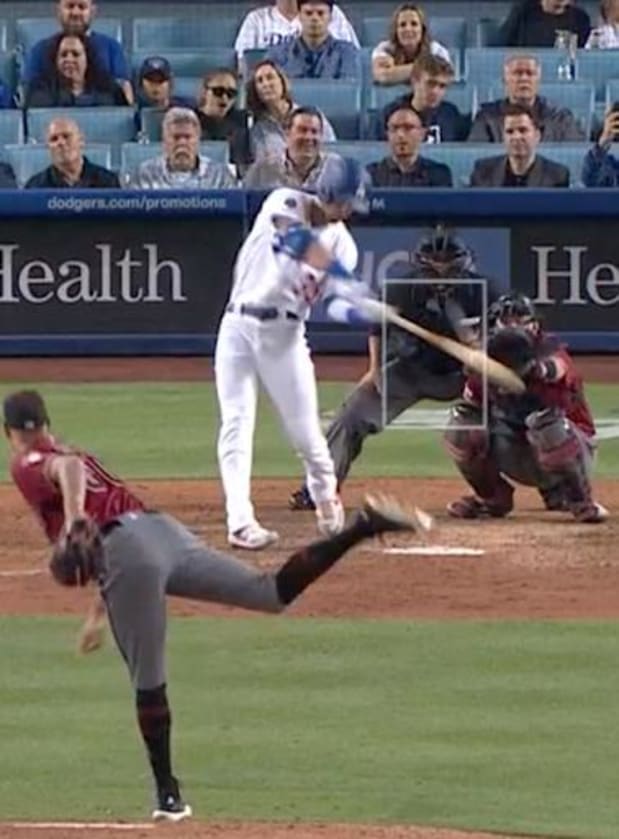
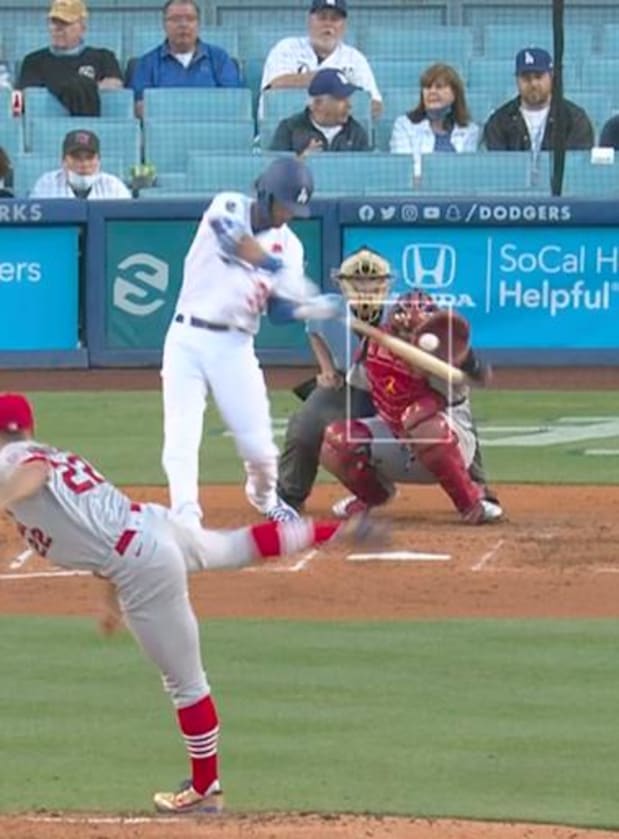
The other difference to note in the above swings is that Bellinger was late on the fastball from Flaherty. The barrel is not yet in the strike area for solid contact.
A major flaw developed in Bellinger’s swing last year: a loop that prevented him from getting to fastballs, especially elevated ones. Bellinger is such a gifted athlete with tremendous bat speed that he hits with an extraordinarily fast burst of energy. He has no trigger mechanism. Most hitters move their hands or front foot early as a timing device. Bellinger stands still until the moment the pitcher gets to his release point. Only then does he begin to lift his front foot. I can’t recall another hitter who waited so long to create tempo. Bellinger can do that because he is a fast-twitch mover who gets the bat into the zone in a flash.
But last year, Bellinger inadvertently added length to his swing that caused him to be late on fastballs. He hit .121 on above-average fastballs (94+ mph), including .069 when they were thrown above his hands.
The length came from dropping the barrel farther below the pitch. Here is an example of how Bellinger was beaten by taking a greater attack angle to pitches.
Here we have two high fastballs to the same spot. On the left is a 95 mph fastball from Joe Ross on July 4, 2021. On the right is a 95.6 mph fastball from Luke Jackson in the ’21 NLCS Game 3.
Note the difference in the angles of his left wrist. In July, the wrist is in a weak bent position, allowing the barrel to dip. That creates a steeper angle of the shoulders and slows the swing. (Think of a swing as no different than a bicycle; it’s slower going uphill.) That’s why Bellinger suffered so much swing-and-miss and launch angle to his game.
The home run against Jackson shows a flatter and stronger angle of the left wrist. He is getting on top of the ball—which is not true literally but is an expression for reducing how far the barrel must travel uphill to the ball.
I used the 2021 NLCS home run because Bellinger was a different hitter in the postseason. He slashed .353/.436/.471 in the postseason, including .333 against fastballs. He cut his launch angle from 22.2 degrees to 8.
July 2021 vs. October 2021
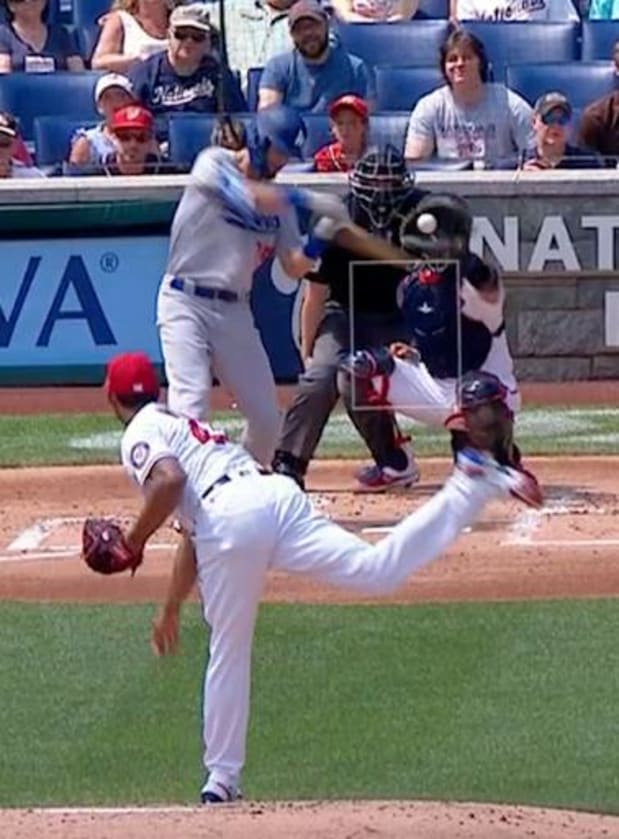
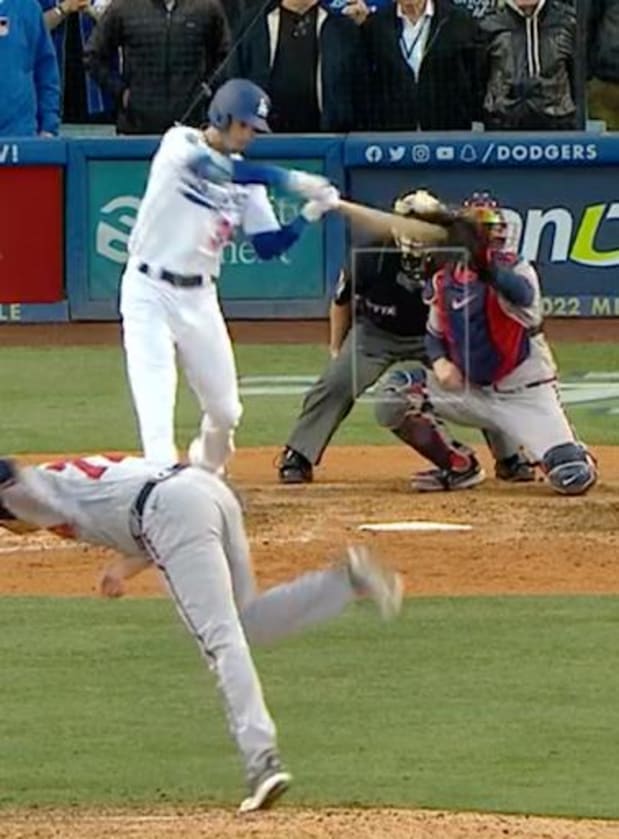
What the Future Holds...
So great was Bellinger in 2019 that it might be asking too much to return to that level. But he stands a very good chance of returning to near that level. The adjustments he made in the ’21 postseason should be encouraging for the Dodgers. Bellinger is still just 26 years old and is a phenomenal athlete. Lynn, another fast-twitch guy who fought injuries, is a better comp than Burroughs, a bulky slugger. Lynn had his best season at 27, though after that he never again cracked a .900 OPS.
Bellinger’s greatest threat is his health. He suffered the hairline leg fracture when Oakland pitcher Reymin Guduan stepped on him on a play at first base. He suffered the rib injury on a light collision with teammate Gavin Lux. As a loose-jointed fast mover, Bellinger should give his shoulder constant attention and maintenance.







